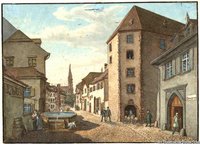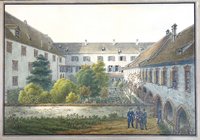The Upper College: a new cloister for the university
In 1532, the university acquired a second location in addition to its building on the Rheinsprung: the former Augustinian monastery.
In 1276, the Augustinian Hermits settled in the densely populated area between Martinsgasse and Augustinergasse; their monastery was first mentioned in 1290. By 1313, they had expanded their property toward Cathedral Square, thus creating a cohesive monastic district. The complex of late medieval buildings included a slender, tall church along Martinsgasse, with its polygonal choir protruding into Augustinergasse. The convent buildings stood along Augustinergasse, positioned at right angles to the church and forming another right angle along the street. The buildings enclosed a horseshoe-shaped courtyard, which housed a garden and a spouting fountain.
During the Reformation, in early 1528, the prior and the remaining five monastery brothers left their order and entered into marriages. The monastery, with all its possessions, fell to the city of Basel, which made it available to the university from 1532. Subsequently, it housed classrooms and ceremonial rooms, along with a boarding house for scholarship students, the Alumneum. In reference to the (Lower) College located further down on the Rheinsprung, the Augustinian monastery was called the Upper College.
At the beginning of the nineteenth century, the buildings of the Upper College no longer offered sufficient space for the university. In 1836, Building Inspector Amadeus Merian was commissioned to develop a spatial plan for a new multipurpose structure that would also house the university’s collections and library.
The Natural History Museum
During the planning, however, the idea of a new building for the university gradually faded away, replaced with a vision to construct a new city museum. A citizens’ initiative strongly supported this project, raising significant funds. And as the university raised no objections, the dedication of the museum in 1849 meant that it once again found itself limited to the single building on the Rheinsprung.




